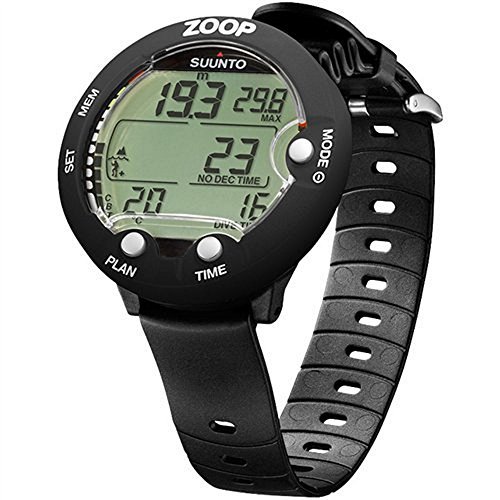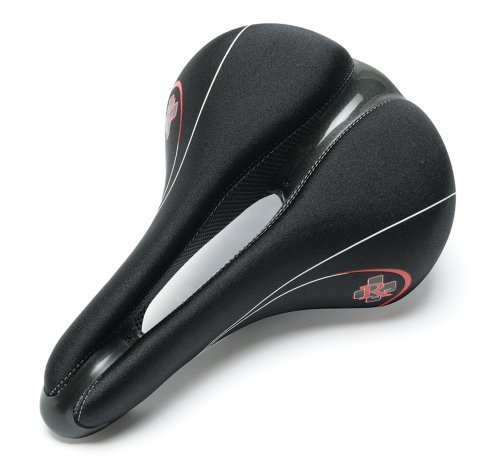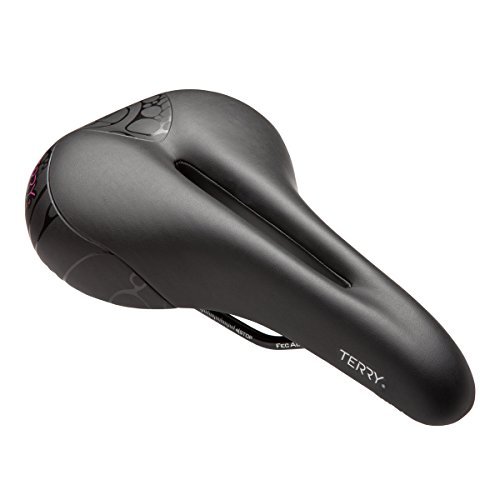
Suunto Zoop Novo Dive Computer Wrist Watch

by people ...
Product Specifications
- Suuntos incredible entry level computer
- Air and nitrox up to 50%
- Easy to use diver interface, easy to read screen
- User changeable battery, audible alarms, built in dive planner
Suuntos RGBM algorithm
Product Description
The Zoop Novo is a great value, easy-to-operate dive computer that is now easier to use then ever! The new design uses the intuitive 4 button navigation found on the D-Series instruments, as well as an improved easier to read display with an enlarged matrix screen that offers better contrast and readability.
Product Reviews
An excellent device for the price
Here are the features I found important in choosing the Zoop:1. Big, easy-to-read display.2. Ease of use.3. Nitrox ability.4. Audible alarms (user-adjustable as to whether they sound).5. Altitude setting.6. Personal adjustment (to make the computer more conservative).7. Ability to record the dive data manually8. User-replaceable battery.Here are features that I did not consider important, and the Zoop, being a basic computer, does not have them:1. Air integration.2. Tri-mix or ability to switch gases during a dive.3. Compass.4. Fresh-water setting.In terms of easy-to-read display, the Zoop gets an A. To give you an idea of the size of the display, the outside diameter of the bezel is 60 mm, or about 2-3⁄8”. The display itself is around 40 mm, or about 1-3⁄4”. Although the computer will show the current time, it is too big to wear as an every-day wrist watch (and the display turns off after five minutes of inactivity).The display does not have a back-light, but I don’t miss that feature. In all the day-time diving that I did, the display was always really easy to read. True it was in the Bahamas, where the water is very clear, but at 134 feet, there was no problem whatsoever reading the display. On the one night dive that I did, I had a light, and I could read the display with the aid of the light. If you were into night diving, the lack of back-light might be a deal-killer.In terms of ease-of-use, the Zoop gets a B+. The default display shows the current depth and maximum depth, the elapsed time of the dive (“DIVE TIME”) and the no-decompression-stop time remaining (“NO DEC TIME”), and the current temperature. If the dive becomes a decompression dive, the time needed to ascend, including stops, is shown (as “ASC TIME”) in lieu of the no-decompression-stop time remaining. It also automatically goes into a count-down for the three-minute safety stop when you ascend to 20 feet. At the surface, the surface interval and no-fly time are shown by pressing the TIME button. All of this is pretty straightforward and thus intuitive.But the Zoop doesn’t get an A on ease of use because some of the other information is not so intuitive and can only be understood after studying the manual. This is a problem with all dive computers, I suspect (unless they have a scrolling plain-language display–and there may be none that do because of the limited space on the display).I don’t understand one reviewer’s comment that he couldn’t distinguish the no-fly symbol from the no-dive symbol. So far as I can tell, there is no such no-dive symbol, and I don’t know what might be confused with the no-fly symbol (an airplane with the word “no” above it). In any event, I have corrective lenses in my mask, and none of the symbols was hard to read (even if some of them are cryptic in the absence of careful study of the manual).The manual could have been written better, but it is adequate. In some cases the manual is understandable by a novice dive-computer user (or perhaps to anyone new to this device) only after doing some dives and getting some data on the computer and also getting some experience using the computer in different situations. After a while, through trial and error and reference to the manual, the menus become second nature. A few of the warnings, however, require some memorization.There is no printed manual, and I found it a big help to print out the .pdf of the manual with two pages to each sheet of 8-1⁄2” x 11” paper and to print on both the front and the back of each sheet so the pages fit compactly in a binder. It’s important to be able to flip back and forth because the illustrations are often on different pages than the associated text.There is an online class that teaches the Zoop, and my device came with a coupon that gave me online access for one year. Even if there no coupon is offered, the course only costs $4.99. Here is a link:[…]The alarms feature gets a B. The only user-adjustable alarms that sound are the ones set for maximum depth and maximum time. There is also an audible alarm for exceeding the ascent rate or exceeding the ceilings for a mandatory safety stop or for a decompression stop ceiling. The audible alarms are adequate in terms of loudness–but just barely. That may be less of a problem as I get more accustomed to the sound of the alarm and thus perceive it more readily. There is also a visual ascent rate indicator, and the audible alarms are accompanied by visual indications (either blinking or a word or symbols) on the display.The user can set the computer to display imperial or metric units (feet or meters, ºF or ºC).In terms of battery life, I purchased the computer a little over a year ago, and it still shows four bars (the maximum) for the battery.Yeah, the cable is expensive, but one argument in the company’s favor is that the cable includes the cost of the software, which can be freely copied whether the company allows it or not. Since I don’t do enough diving to need a computer program to log my dives, I found manually writing down the essential information and entering it into a spreadsheet to be sufficient for my purposes. The only information that would be tedious to record would be the profile of the dive, the depth of which is shown in the logbook mode every 30 seconds.The band is so long that it curls around the wrist until it covers the display. I had to keep pushing it away to read the display until I trimmed it (easy to do). But because I don’t know how thick a covering might one day be on my wrist, I only cut the portion that overlapped the display, leaving a band that still left plenty of room to cover a thicker exposure suit.The Zoop is reputed to have a conservative algorithm, and on one dive, I went into deco mode, though no one else did. According to the divemaster, the Zoop doesn’t like the 45-minute time surface interval that was used for our dives, preferring instead a one-hour surface interval. Since all any dive computer does is to predict whether (and for how long) you have to decompress to avoid getting decompression illness (aka “the bends”), diving within the limits established by the computer does not prevent you from getting an “undeserved” DCI hit, though that would appear to be rare. I wanted a conservative computer so I have no complaint about the conservative nature of the Zoop.The other main contenders in this price bracket are the Mares Puck and the Leonardo Cressi. I haven’t used either, but I suspect you can’t go wrong with any of these computers. Just look for the features that you know you want (and find out through your research about the features that other people wish that the computer had) before making a choice. For example, some complain that the Cressi does not automatically count down for the three-minute safety stop. Whether that is correct or not (could be user error), that would be a deal-killer for me. But others who only dive in groups with a divemaster who directs the safety stop or who wear a watch with the computer might not care.Having used the Zoop for 17 dives in the Bahamas and having studied the manual, I am satisfied with it, and I consider it an excellent device for the price. For $250, it gets five stars.
Best Buy for the dollar
Fantastic first time dive computer. I have several high end dive computers, but needed something for quick recreational dives. I’m really impressed with the quality of Suunto Zoop, especially considering cost. I highly recommend this for any basic dive student to dive master.
Great first dive computer!
Great value, entry-level computer. Works great, and has all the features I need as a new diver. Was recommended by my first instructor and will definitely use for years to come.
Nice computer for the money
Nice computer for the money, I have used it on over 50 dives now and it tells me all I need to know to keep safe and have an enjoyable dive. My only complaint is that it doesn’t include the USB chord, and the price they charge to buy that is really outrageous. Otherwise, I am happy with this product. Definitely take the time to learn how to use it, my computer came with a link to an online course that was very useful.
Great computer
This computer does everything I need. I’ve used it on a dozen or so dives in the last 4 months, max depth 99’. You can read up before you use it or just hit the water. It activates itself at about 2’ and guides you from there. Beeps at you if you are ascending too quickly. Beeps at you if you are about to pass no decomp bottom time. If you do, it builds in your stops. It held me at 15’ for some extra minutes on a dive where I went over. I feel very comfortable with this computer. I’ve been diving over 40 years and finally got a computer and I like it a lot. I bought the cord to connect it to a PC but it didn’t fit. I want to get one so I can keep a landside record as well as on the dive computer. I sent the cord back and contacted the seller. Here’s what they said in reply:Certainly, we have them fulfilled by Amazon if you search this asin B007P4FML6It is confusing because you probably got the old zoop cable. The new zoop novo takes the one like the watches. They call it the d series.
ok for the price you pay
this is a reliable entry level dive computer- the only thing I don’t like (hence the 3 stars) is that it’s very hard to read in darker water- you have to get the flashlight out. The audible alarms are nice. It’s not that user friendly- takes some getting used to it.
I like the size
I like the size, readability and fit. The backlight function make it suitable for occasional night dives. It covers all the needs for non professional diving. Initially I thought it would have been nice to also have the compass function, but then I realized that it would have cluttered the device. Compasses are cheap and widely available. Wearing a compass in addition to the Sunto Z Novo provides better reading of both instruments.
It’s a basic but solid computer that handles Nitrox well and is easy to read and understand all the information on it
Lost my old dive computer last year and bought this to replace it, as I needed a new one but didn’t have a whole lot of money to spend. Dove this weekend in the Gulf of Mexico, and it worked well for my needs. It’s a basic but solid computer that handles Nitrox well and is easy to read and understand all the information on it. Gets the job done!
Still assessing
Can’t really offer a proper review yet. On my first dive, the computer cut out in shallow water (3-4 meters) and the dive log disappeared and the computer reset to factory mode.
Five Stars
Exactly what I need!
Best for price
Best for prices
Five Stars
It’s perfect for a beginner diver
Five Stars
Great device, easy to use, little bit bulky but bang for buck
Excellent value fully capable nitrox computer.
Great value for an awesome computer. I have had several Vypers and this is just as capable for the typical Nitrox diver.
Great for the new or casual diver like me!
Worked great on my certification and first dive trip. 12 dives total now and no issues. Had no problem connecting to the software and syncing the dive data after the dive.
Best dive computer for beginners!
First time diving in almost 5 years and I decided to buy a computer after discussing it with my dive instructor (refresher course).
Best First Time/Affordable Computer out there
This is an outstanding beginning dive computer. I just used the computer on multiple dives and it worked perfectly as advertised.
Big but just what I wanted, a dive watch!
comments powered by DisqusBand is designed to be worn over a glove and wet suit. I wore gloves, fit good. The buttons are big enough to be felt and used more easily when wearing gloves.

